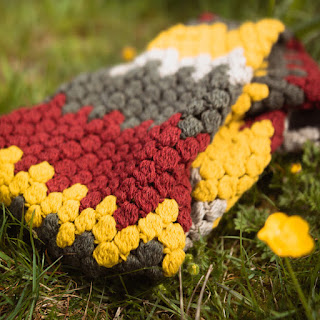Why Yarn Weight Matters
Yarn weight, also known as yarn thickness, is a crucial factor in producing the results of crochet projects. Choosing the right yarn weight will determine the gauge, size, texture, drape and even the warmth of your finished piece. Read on to learn about the various yarn weights and their uses.
A Breakdown of the Different Yarn Weights
Let's first of all explore the common yarn weights from the thinnest through to the thickest:
Lace Weight:
Also known as: (0), Extra Fine, 2ply
Characteristics: The thinnest yarn, it’s extremely fine and delicate.
Common Uses: Shawls, doilies, other intricate work.
Hook: 1.5mm-2mm
I recommend: Rowan Fine Lace, Zakami Fluffy Lace, Debbie Bliss Rialto Lace
Fingering Weight:
Also known as: (1), Super Fine, 4ply, Sock Yarn, Baby Yarn (this is my favourite yarn weight!)
Characteristics: Fine, but thicker than lace weight.
Common Uses: Socks, hats, baby blankets, lightweight sweaters.
Hook: 2.25-3.25mm
I recommend: Hedgehog Fibres Sock Yarn, Coop Knits Socks Yeah, West Yorkshire Spinners 4ply Sock Yarn
Sport Weight:
Also known as: (2), Fine, 5ply, Heavy Fingering, Light DK
Characteristics: Versatile weight, not too heavy, not too light! More common in the USA than in the UK.
Common Uses: Sweaters, shawls, afghans.
Hook: 3.5-4.5mm
I recommend: Mrs Moon Pudding, Drops Alpaca Sport, Manos Serena Sport
Double Knitting:
Also known as: (3), DK, Light Worsted Weight, 8ply
Characteristics: The most common yarn weight, easy to work with.
Common Uses: Blankets, hats, scarves, toys.
Hook: 4.5-5.5mm
I recommend: The Scottish Yarn Festival Clan DK, Debbie Bliss Rialto DK, Scottish Balmerino DK
Aran Weight:
Also known as: (4), Worsted Weight, 10ply
Characteristics: A very popular yarn weight, easy to work with.
Common Uses: Blankets, hats, jumpers, scarves.
Hook: 5.5-6.5mm
I recommend: West Yorkshire Spinners The Croft Shetland Aran, Rowan Felted Tweed Aran, Uist Wool Meireal
Chunky:
Also known as: (5), Bulky Weight, 12-14ply
Characteristics: Thicker yarn, perfect for quick projects!
Common Uses: Cushions, rugs, oversized scarves.
Hook: 6.5-9mm
I recommend: Malabrigo Chunky, Drops Andes, Rowan Big Wool
Super Chunky:
Also known as: (6), Super Bulky Weight, 16ply
Characteristics: Extremely thick yarn, ideal for large, bold projects, works up very quickly.
Common Uses: Rugs, household items such as cushions.
Hook: 10-15mm
I recommend: Manos Franca, Wool And The Gang Crazy Sexy Wool
Pro tips on Yarn Weight:
If the weight is unspecified, use the hook or needle size on the ball band or label as a clue to yarn thickness.
The higher the meterage per 100g, the finer the yarn. Conversely, a lower meterage per 100g indicates a thicker yarn.
If you’re substituting yarn for a pattern, choose something which is similar thickness for best results. If you’re looking for more information on substituting yarn, take a look at this previous blog post I’ve written on the topic.
The size of the crochet hook you use will also affect the finished size and texture of your project. As a rule of thumb, a finer yarn requires a smaller hook, while a thicker yarn requires a larger hook.
How to calculate yarn thickness using a ruler:
You can determine yarn thickness by wrapping yarn around a ruler, known as the wraps per inch method. Take the ruler and wrap the yarn snuggly around it, then count the number of wraps in a one-inch section. A higher number of wraps indicates a finer yarn, while a lower number signifies a thicker yarn, as follows;
Lace Weight: 14-30 wraps per inch
Fingering: 12-18 wraps per inch
Sport Weight: 11-15 wraps per inch
Double Knitting: 9-12 wraps per inch
Chunky: 6-9 wraps per inch
Super Chunky: 5-6 wraps per inch
This wrapping method provides a quick and easy way to estimate yarn thickness for those times when you don’t have the label. However do keep in mind that these are guidelines, some variations may occur.
Conclusion
If you’re a crocheter (or a knitter!), gaining a good grasp of yarn weights will unlock the key to your crochet and knitting potential. By selecting the appropriate yarn weight for your project, you will achieve the desired look and feel you envisioned. Once you know what you’re doing, you’ll then have the confidence to experiment with different yarn weights to create unique and stunning crochet projects.
Until next time, happy crocheting,
Marta xx



.png)








